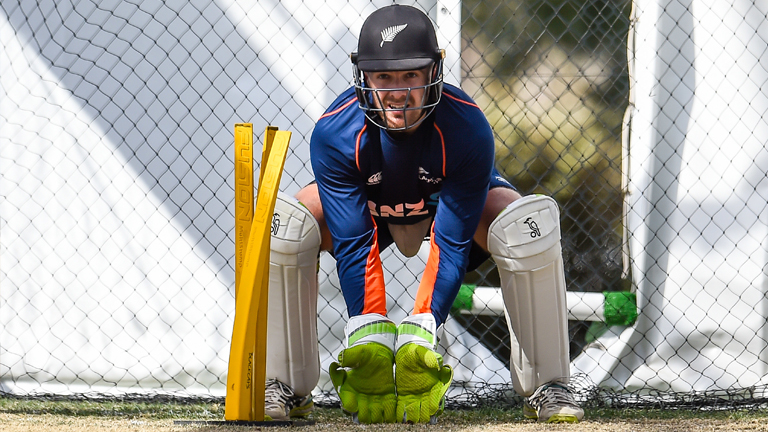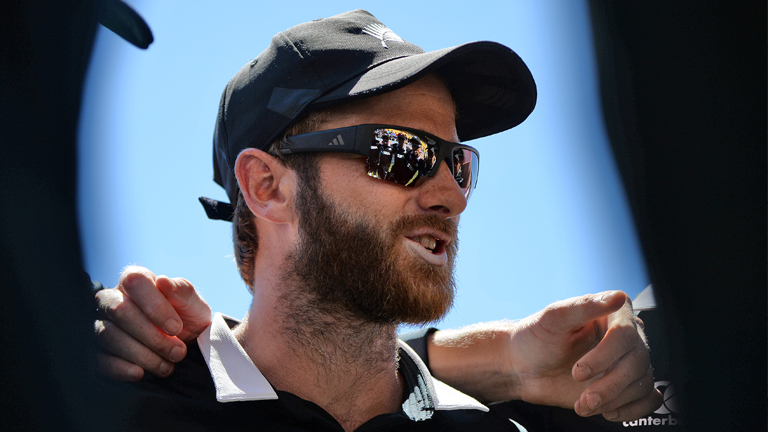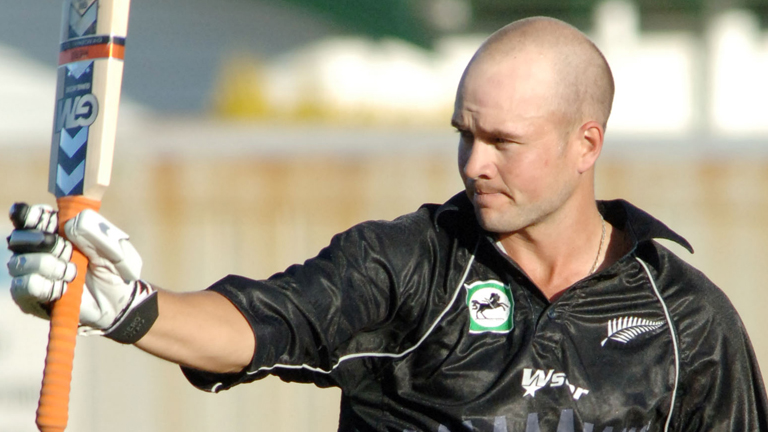Meet the Black Caps
Meet the Black Caps.


Given the honour of captaining his country for the first time at an ODI World Cup, it’s probably not a simplification to suggest that if Kane Williamson fires, the Black Caps will also. The 28-year-old has had a middling stretch in the 50-over format by his superb standards – not scoring an ODI century since March 2018 – while he also struggled to get amongst the runs early on in the Indian Premier League after recovering from a rare shoulder injury. Williamson has never passed 57 in 13 World Cup innings – more of a curiosity than a concern, one would venture - and rest assured, New Zealand’s star leader will need to top that high score if his side are to have any chance of making the semifinal stage. Given the skipper’s class, it’d be a safe bet to assume he steps up when required.

When someone can smite the second highest score in ODI history, at a World Cup, on home soil, and it’s still not the most memorable highlight of the event for New Zealand, then it must have been a pretty special tournament. Such was life for Martin Guptill and the Black Caps in 2015, but Grant Elliott’s semifinal winning six by no means made Guptill’s unbeaten 237 against the West Indies any less stellar. The 32-year-old is still capable of something similar at this World Cup, and even though he went through a horror spell earlier this year – failing to pass 15 in six straight games – he showed his class by then blasting back-to-back rapid centuries against Bangladesh. A double ton might be asking a lot, but Guptill can certainly win New Zealand a game over the next month.

Perhaps the biggest unknown in the Black Caps’ expected starting XI is the question of how Henry Nicholls will fare as an opener. Some promising knocks in the middle order – including a stunning unbeaten 124 off just 80 balls against Sri Lanka – combined with the poor form of Colin Munro to give Nicholls the unexpected nod as New Zealand’s first-choice opener at the World Cup. He hasn’t had much of a chance to prove his worth – 30*, 8, 53 and 14 were his four contributions when opening this summer – and while he has the pedigree and the theoretical ideal mix of abilities to snugly fit the role, Gary Stead’s late change is still a reasonable gamble to have made, this close to a major event.

Undoubtedly New Zealand’s greatest ODI batsman – at least until Williamson begins to hunt down his many records - this will almost certainly be Ross Taylor’s last World Cup, and the 35-year-old is perfectly poised to make his biggest impact yet. List practically any ODI batting stat in the past few years, and you’ll find Taylor’s name near the top - usually second only to India’s Virat Kohli. Since 2017, Taylor has averaged 70.9, breezing past many of New Zealand’s ODI records, but at World Cups, he averages 36.2, with just the one century - 131* against Pakistan in 2011. Considering the form he’s in, it would not be a surprise to see Taylor add to that tally in the United Kingdom.

New Zealand’s unquestioned first-choice ODI wicketkeeper and a valuable piece of the middle order, Tom Latham is expected to play a major role in every game at the World Cup. Underutilised during the New Zealand summer – he was rested or not required to bat in over half of the Black Caps’ ODIs – Latham looked extremely solid when he did spend time in the middle. Latham passed 30 in four of his five ODI knocks in 2019 – all in reasonable time, rotating the strike well – but never reached 60. Ideally, that would be just fine for the Black Caps, as they would prefer their runs to be scored by the top four, but Latham looks like he could also be the man for a crisis if he’s needed to craft a lengthy innings.

Colin Munro’s ODI summer started promisingly enough, blasting a career-high 87 in the Black Caps’ second game against Sri Lanka. Unfortunately for the 32-year-old, that was as good as it got, as he failed to pass 31 in his next six innings – extending a year-long stretch in which the aforementioned Sri Lankan knock was the only time he passed 50. While his aggressive style can pay big dividends, he and Martin Guptill’s opening combination had a shocking run, leaving Henry Nicholls to be promoted in his place. Munro could still have value at the World Cup as a utility batsman, one capable of hitting out in the middle order, while his unthreatening but tidy medium pace offerings can also chew through a few cheap overs if required.

The massive bolter in the Black Caps’ World Cup squad, Tom Blundell got the nod as back-up wicketkeeper over the promising Tim Seifert, as a result of his superior glovework. It’s unlikely Blundell will play at the Cup unless there is an injury to Tom Latham, in which case he will swap directly in at number five, leaving him as a rather one-dimensional squad option. However, the Black Caps selectors felt they needed a reliable pair of hands behind the stumps if anything were to keep Latham sidelined for an extended period of time, and while Blundell’s domestic one-day record is hardly stellar, he showed promising signs when playing for the New Zealand XI against the Australian XI in Brisbane earlier this month.

12 months ago it seemed likely Jimmy Neesham would be left on the outer for a second straight World Cup, after missing out on the final all-rounder spot to Grant Elliott four years ago. He struggled with injury and form in 2018, leaving an 18-month gap where he didn’t feature for New Zealand. However he made the most of an ODI recall at the start of the season, putting in strong performances against Sri Lanka, India and Bangladesh. The highlight of his summer was some superb late hitting against Sri Lanka. He smoked an incredible 47 off 13 balls, including 34 runs off an over (a New Zealand ODI record) in the first ODI, before bashing 64 from 37 balls in the next game, backed up by two wickets and a run out to set up a Black Caps win.

Possibly the ultimate X-Factor in this New Zealand side, Colin de Grandhomme is the type of player who can take an innings away from an opponent when he’s on form, or simply extend the misery after a fine top order display. He showed that in the last ODI of the summer, where he bashed an unbeaten 37 off just 15 balls against Bangladesh – a much-needed knock after some poor form, and he could be a valuable asset on pitches which are expected to be high-scoring. Much like his batting, his bowling can also be a mixed bag, and the Black Caps will need de Grandhomme to be at his brutal best if they are to maximise their potential. If not, he may find himself benched for some of the other all-rounders in the squad.

The Northern Districts left-arm orthodox spinner made his New Zealand debut following the retirement of Daniel Vettori at the conclusion of the 2015 World Cup. The comparisons with New Zealand’s leading one-day wicket taker were expected, with Mitchell Santner also being a left-armer, however he looks more orthodox with bat in hand. Santner underwent a nine-month injury break in 2018 after knee surgery, returning over the recent summer series against India and Bangladesh. As well as being New Zealand’s likely top spin option at the World Cup, Santner offers a strong option with the bat, proven by a successful series against England last year which included scores of 67, 63, 45 and 41 in his four innings.

The right-arm legbreak bowler won the second spin bowling place in the World Cup squad over Todd Astle. Ish Sodhi had a solid home summer, recording the most wickets (eight) in the three-match series against Sri Lanka, and being relatively economical. Sodhi made his ODI debut in Zimbabwe four years ago, and has recently been competing with Santner and Astle for a regular spot in the side. His best ODI bowling performance came in a thrilling victory over England last year, taking 4-58 as New Zealand chased down 336 to win in Dunedin. The unknown for Sodhi is how he’ll perform on British wickets, having yet to play an ODI in England or Wales.

Tim Southee will play in his third World Cup after previously taking part in the 2011 and 2015 tournaments, where he recorded a combined 33 wickets with an impressive bowling average of 23.75. The 30-year-old’s best performance at the World Cup came in the 2015 pool game against England at Westpac Stadium, where he ripped through the English batting order to finish with 7-33 – the best ever ODI figures by a New Zealand bowler. His opening bowling partnership with Trent Boult across all three formats has been vital to New Zealand’s success over the past seven years, and while Southee was used sparingly over the New Zealand summer, he ended it on a high, taking six wickets in the final ODI against Bangladesh in February. His spot in the starting XI won’t be guaranteed though, with four solid options with new ball in hand.

Matt Henry heads to his second World Cup after a brief taste at the back end of the 2015 tournament, having come in as an injury replacement for Adam Milne. The Canterbury fast bowler slotted straight into the starting XI for the semifinal win over South Africa, recording figures of 0-40, and took two wickets in the World Cup final defeat to Australia. The British conditions at the World Cup should suit Henry, who took 65 wickets across all competitions for Kent in 2018, tied for second on the wicket charts in the one-day format. After sitting on the outer for most of 2018, Henry had the new ball in hand throughout the bulk of 2019’s ODI matches, setting up a fine partnership with fellow opening bowler Trent Boult.

At the start of the summer, before taking the field in the United Arab Emirates against Pakistan, Lockie Ferguson had an ODI bowling average of 35.6 and an economy rate of 5.8. Now, after a summer where he claimed 25 wickets at 22.5, his career record has improved to a 28.4 average and 5.6 economy – with the rapid 27-year-old emerging as a vital option at first-change for the Black Caps. Ferguson took two or more wickets in eight of the 11 ODIs he played this summer, and while some of them came with the territory of bowling at the death, his express pace also offers a different dimension that could trouble the world’s best batsmen in the United Kingdom.

New Zealand’s bowling spearhead in all formats, Trent Boult’s career record compares favourably against all-comers. For instance, this World Cup will likely see him vault past both Shane Bond and Richard Hadlee in ODI wickets, and his bowling average (24.7) and economy rate (5.1) are exceptional considering his role and era. His career-best figures – 7-34 against the West Indies in 2017 – are also the second best by a New Zealander. So when Boult went through a dry patch earlier this season - conceding 60 runs in four straight games - it was only a matter of time before he delivered, and sure enough, a stunning display against India (10-4-21-5) was followed by a solid string of performances to show he’s back to his best ahead of the World Cup.
Four years ago, the Black Caps reached their first World Cup final with a dramatic second-last ball victory in the semifinal against South Africa. They were, however, comprehensively beaten in the decider by Australia. On June 1, Kane Williamson and his 14 charges start their 2019 campaign, hoping to go one better.
Saturday, June 1: 9.30pm:
NZ v Sri Lanka
(Cardiff Wales Stadium, Cardiff)
Thursday, June 6: 12.30am:
NZ v Bangladesh
(The Oval, London)
Sunday, June 9: 12.30am:
NZ v Afghanistan
(County Ground Taunton, Taunton)
Thursday, June 13: 9.30pm:
NZ v India
(Trent Bridge, Nottingham)
Wednesday, June 19: 9.30pm:
NZ v South Africa
(Edgbaston, Birmingham)
Sunday, June 23: 12.30am:
NZ v West Indies
(Old Trafford, Manchester)
Wednesday, June 26: 9.30pm:
NZ v Pakistan
(Edgbaston, Birmingham)
Sunday, June 30: 12.30am:
NZ v Australia
(Lord's, London)
Wednesday, July 3: 9.30pm:
NZ v England
(The Riverside Ground, Chester-le-Street)
Tuesday, July 9: 9.30pm:
Semifinal 1
(Old Trafford, Manchester)
Thursday, July 11: 9.30pm:
Semifinal 2
(Edgbaston, Birmingham)
Sunday, June 14: 9.30pm:
Final
(Lord's, London)






